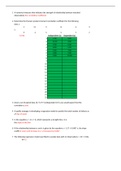Samenvatting
Summary information management (TISEM)
- Instelling
- Tilburg University (UVT)
Uitwerkingen van de colleges aangevuld met de bijbehorende stof uit het boek van Gabriel Piccoli. Alle informatie nodig voor het tentamen information management (TISEM pre-master information management)
[Meer zien]













